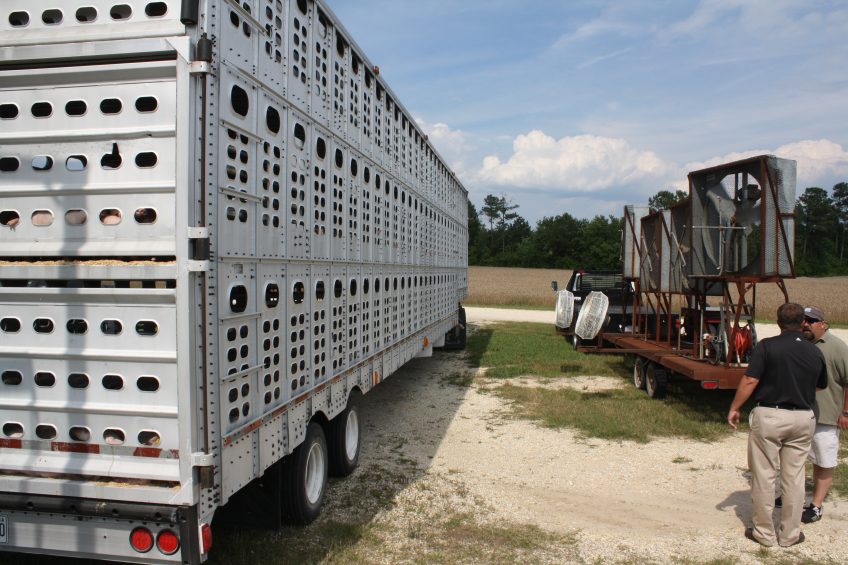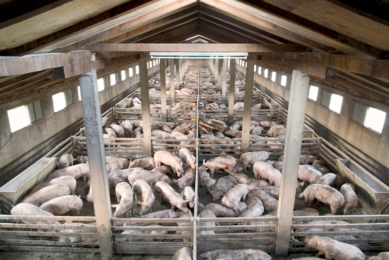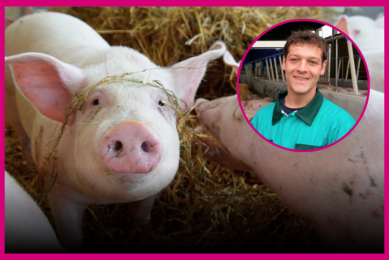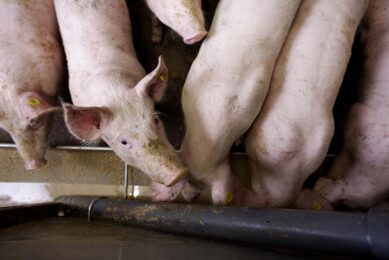North Carolina: No corn, but great pig farming

North Carolina is the United States’ second-largest pig state. Far away from the corn belt, and surrounded by forests, circumstances are good for swine production, explains David Herring, of TDM Farms, Newton Grove, NC. He heads a multistate 18,000 swine integration.
A door is opened, and out come a small group of pink creatures. Hesitant at first, the piglets look round. Soon, more follow, the group grows and the piglets push each other forward. From inside the building, a rattling sound grows stronger and makes the young pigs move on further. Uphill they go, into a large multistorey vehicle.
This Monday is transport day at TDM Farms, at Newton Grove, North Carolina. For 2,200 just-weaned piglets, the biggest journey of their life is to follow, as the large truck will take them for a fourteen hour non-stop journey to Indiana. TDM Farms has about 18,000 sows in own facilities as well as in contract breeder farms in North Carolina. From here, they send the piglets to the Mid West for growing and finishing.
The finishing is carried out there for economical reasons. Building new pig houses in the direct surroundings is virtually impossible since hog production in Sampson county is so concentrated, that permits are rare. Finisher production in the Mid West pays off for two reasons – it’s easier to get rid of manure and the vicinity of corn.
In total, TDM has 45 contract farms for its finishers, of which 40 are located in Indiana. This makes the total number of pigs sold to the market every year about 500,000.
Contract growing
The system of contract growing is a phenomenon that originated in North Carolina – for more information on the background, see box. The method helped the state to develop itself to become the second-largest hog producer in the United States after Iowa. Conveniently located at the Atlantic coast between major consumer areas of New York City and Miami, North Carolina houses to date around 850,000 breeding sows and 7.7 million market pigs, according to the USDA Hogs & Pigs Report, published in the end of June 2012.
Hogs in North Carolina are very concentrated, as Duplin, Sampson and Bladen counties together already house more than half of these – about 5 million hogs. In Bladen county the US’ largest pork processing facility can be found, owned by Smithfield Foods. The plant has a capacity of 30,000 pigs/ day.

Forests
TDM Farms is headquartered in Newton Grove, located in the north of Sampson county, at about 75 km south of the state capital Raleigh. Typically, the surroundings do not resemble those in the Mid West in any way. Instead of the yellow of corn production, North Carolina colours green of forests. “That is why this state has a permanent 180% feed deficiency,” says David Herring, 51, grinning.
David Herring is the ‘D’ in TDM Farms, which is co-owned by him and his brothers Tony and Mark. Swine farming in North Carolina is good business, he explains. “We may be located miles and miles away from the main corn production area, but North Carolina does offer a couple of significant advantages, which make up for the extra travel costs we make to have the feedstuffs that have to be trucked into North Carolina. For instance, we do have more abundance of labour here.”
One more advantage is hidden in the North Carolina climate, which is milder as the Atlantic Ocean is near – so both summers and winters are better to cope with. In winter, temperatures rarely drop below the freezing point at night, which means few, if any, snow. This has an effect on building costs, Herring explains. “Buildings don’t have to be made extra secure to withstand layers of snow on the roofs. On top of that, energy costs are less as we don’t have to heat the buildings that much in winter.”

Family business
Also being involved in livestock equipment company Hog Slat, David Herring states that the total family business could be best described as an equipment manufacturer with additional pig farming branch. “It works both ways,” explains Herring. “As we do pork producing as well, we know first hand what equipment is needed. We keep on learning every day. On the other hand, new products can be tested and tried in our own farms as well.”
For these purposes, TDM owns four more or less identical breeding sites in the direct surroundings of Newton Grove, each having three lateral buildings each and housing about 2,600 sows. It was to one of these, built in 1997, that Pig Progress paid a visit. A good example of testing and trying is the Sow Max, a relatively novel ad lib stainless steel feeder type for use in lactating sows. The feeders, which can be adjusted into any existing automatic feeding system, come equipped with a little swing. Sows can operate a switch with their snouts to make the feed drop down, thus ensuring feed to remain fresh and ultimately to create higher sow weights at weaning. The sows are fed a mixture of grains and soybeans.
The lactating sow section is divided in eight lactation rooms of 52 crates. The house is naturally ventilated with curtains on either side which can be lowered in case the temperatures would require this.

Dry sow section
Unlike the lactating sow house, the adjacent dry sow section is a tunnel ventilated building. The dry sows are on a restricted feeding regime, which changes depending on their stage of gestation. The sows are kept in gestation stalls – all produced by Hog Slat as well. The total complex is completed by a small building for new gilts and a large lagoon for manure.
Last but not least, at the far end of the lactating sow house, there is a special section for 1,100 just-weaned piglets. They will only stay there for a couple of days. Once a next batch of piglets is weaned – the truck will come and get them for their big journey.
North Carolina – quite unlike the Mid West
North Carolina has only had a relative short history as a major pig state. Until the mid-eighties, pig production wasn’t a very prominent business, but only as from 1985 onwards things started to take off for the ‘Tar Heel State’. “A lot of this is related to the tobacco business. Evidence grew for a connection to cancer in this time and it became clear for many tobacco farmers that there was a need for them to diversify,” says Deborah Johnson, CEO of the North Carolina Pork Council.
In a similar set-up as the tobacco industry, a structure of contract growers came into existence. “This is what makes us stand out from the Mid-West, and makes us quite unique,” states Janet Archer, a pork producer from Goldsboro, NC. “My husband and I were also able to set up a 1,200 farrow-to-finish farm by setting up a contract. The farm is ours, but the pigs and all that is on top or in them is owned by TDM Farms – this would included feed and medication. It works well – we share the costs and the risks.”
The growth of the swine industry in North Carolina was spectacular. Since the mid-nineties, NC has been number two seeded, although being still lightyears behind number one state Iowa with its 1 million breeding sows and 18.8 million market pigs.
North Carolina is unique in comparison to the Mid West states – not only for climatic reasons. With 8.5 million inhabitants, North Carolina is far more densely populated than e.g. Iowa. In addition, the swine in North Carolina are unusually concentrated in only a few counties. Since US operations usually operate on multi-site productions, the North Carolina set up results in many pig transports in this pig-dense area. This in turn, results in a relatively high disease susceptibility, with PRRS having proved to be a problem that is difficult to control. A joint, state-wide approach to control PRRS is therefore being set up to better address the problem.
Crop production is another big difference between, with e.g. corn being virtually absent in North Carolina. Projects are, however, underway to find out how feedstuffs yields can be made more profitable when planted in this part of the USA.











